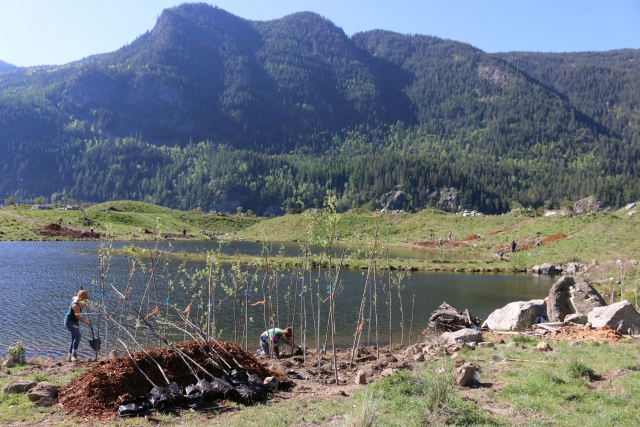Selkirk College Students Assist Arrow Lakes Restoration Project
Selkirk College students in the Integrated Environmental Planning (IEP) Program dug a little deeper into their studies at the end of the semester along the banks of the Lower Arrow Lake.
At the tail end of completing the first year of the two-year program, 17 students gathered in a 50-hectare wetland area just up the lake from the Hugh Keenleyside Dam. In partnership with Columbia Power Corporation, students spent a week planting trees and making enhancements to a restoration area that has become a vital habitat for a variety of species.
“Wetlands are in short supply in the Kootenay, increasing wetlands and their function as a haven for wildlife is a priority,” says Doris Hausleitner, the Selkirk College instructor who teaches the IEP 276 (Ecological Restoration) course. “This wetland in particular attracts a large diversity and density of wildlife.”
When the Arrow Lakes Generating Station project began in 1999, dredged soils were placed on Columbia Power Corporation land across from Broadwater Road. As part of the lost terrestrial habitat, the wetland was created and since that time a successional process has been taking place.
Overall the reclamation efforts have proved successful, but some of the work has been hampered due to poor compacted soils, seeding with aggressive grasses and grazing by ungulates. To help overcome the obstacles, Selkirk College students planted four different species of trees—upland and wetland willows, cottonwood and red-osier dogwood—and created barriers to keep the new additions safe from hungry ungulates.
“This project presents such a great learning opportunity and a unique approach that allows us to apply the lessons learned and build on that knowledge,” says Michael Hounjet, Environmental Manager at Columbia Power. “It is very rewarding to see the students contributing to the overall health of the local ecosystem and they should be very proud. It has been great working with Selkirk College on this project and hopefully this relationship can continue into the future.”
Field work is an important part of the popular Selkirk College program. In past years, students have been involved in a variety different projects around the West Kootenay. Between 2011 and 2015, students worked on Nelson’s eastern waterfront planting and protecting vegetation on peninsulas to prevent erosion and growth of the invasive tansy.
“Students learn different techniques for ecological restoration in the field,” says Hausleitner, who has taught at Selkirk College since 2011. “They are asked to apply the ecology they learned in the past term and think creatively. They also build connections with the community.”
The work on the Columbia Power Corporation wetland is now complete for the season. Next year a new group of students will possibly return to the same wetland and if the techniques used were successful, continue where this group left off.
“We are fortunate to have community partners like Columbia Power Corporation who allow our students these opportunities,” says Hausleitner. “It was a productive week of learning and an experience that students will be able to use once they return to class in September.”
Find out more about Columbia Power Corporation at: http://www.columbiapower.org
Learn more about the Selkirk College Integrated Environmental Planning Program at: http://selkirk.ca/program/iep






















